Preserved: Fruit and Preserved: Condiments
Preserving apples, Q and A with authors Darra Goldstein, Cortney Burns, and Richard Martin and recipes for Black Salt and Fermented Honey Charoset
This morning the sunrise is veiled by low clouds or high fog, depending on how you look it. It doesn’t pull at me to run and frolic in the falling leaves (yes I still build large leaf piles solely for the purpose of jumping in and I bring my grandchildren so I don’t look like a crazy old lady) but it does make this golden litter stand out. The yellow still on the maples and willow are brighter for not competing with the sun. The air is colder, last night’s near full moon and clear sky chill is held in by this blanket, but it moved in right before the frost and so the zinnias growing along my deck were spared one more night. Maybe looking at fog cloaking the hills and causing a dull grey light is a bit like calling the glass half full or half empty.
It is still preserving season. You have been with me in these posts as I’ve shared that plums are piled in my kitchen, then pears, now it is apples. Christopher recently had shoulder surgery, so we are not using our hand-crank cider press this year. Our neighbor is borrowing the press, pressing some of our apples, and sharing some cider. Another neighbor called to pick windfalls for her horse. We are making dried apple chips with as many of the apples as we can. Our grandchildren are thrilled, sneaking their hands into the dehydrator to nibble on these pieces of concentrated sweetness. It has been years since I made apple chips (in favor of cider and vinegar) but I am enjoying the return to this particular preserved abundance.
My own children ate dried apple rings in such great quantities that I sat them down to help. I haven’t convinced the grandchildren this is fun yet. I recently have been reading some old journal entries and found the following from 2006—maybe I need to dig out my even older apple-corer-peelers to entice them.
Ariana and Dmitri are filling the round trays of the dehydrator with apple rings. They each are armed with a large wooden cutting board that has a White’s apple-corer-peeler clamped to the end of it. This is a piece of equipment that is still the appropriate technology for the job, one is circa 1900, the other is from the 1950s and I know brand new ones are still available. The apple comes out in a cored spiral, and if the apple was fairly uniform most of the peel is off in a long string. They compete for length and then eat them.
Preserved Series
In the theme of preservation, I am excited to share a new series of six books that are all about preservation. The series is written by Darra Goldstein, Cortney Burns, and Richard Martin. The first two are out this week Preserved: Condiments and Preserved: Fruit. They ship Oct. 31.
These books offer well-researched methods to preserve abundance in enchanting ways. The books are a feast in more ways than one—the recipes begin with rich headnotes that give the reader historical and cultural context to the preserved food. I feel this series is a treasure that will inspire this generation of cooks looking to preserve fresh ingredients in ways that are delicious, timeless, and fun.
I am pleased to share not only a Q and A with Darra, Cortney, and Richard but also recipes from both books. (Plus an extra recipe for Fermented Apple Butter on my Ferment.works website.) I love that I can share all three voices in this post – as like the microbes we cooperate with – I think collaboration makes things richer. (And of course, more complex in all the ways, which is part of the beauty.)
Meet the team
Cortney is a celebrated professional chef and a fermentation wizard. Darra is a seasoned cookbook author and food historian. Richard is an avid home cook with a strong marketing background who keeps his finger on the pulse of current food trends. You can read more about each of them on the About page of the Preserved Books website.
Q: This is an exciting series, so far, as it looks at the preservation of food through the lenses of all the techniques, historical and cultural context, and modern flavor desires. How did it come about?
DARRA: Do you remember the short-lived journal CURED? (K: I do, here is a post from 2016 when it was ready to launch.) It was a gorgeous publication all about the art of preservation. A single issue appeared in 2016 before the parent company, Zero Point Zero, pulled the plug (they were primarily a video production company and didn’t really understand the world of print). I served as editor in chief and Richard was editorial director at ZPZ. In many ways the journal was ahead of its time, and when the fermentation boom really began to peak a few years ago, Richard and I decided to try to revive the journal. But we couldn’t find adequate funding, even after we brought Cortney into the project. When Jenny Wapner became publisher of Hardie Grant USA, we brought the idea to her. She suggested that we turn it into a series of small cookbooks instead, and so PRESERVED was born.
Q: What did each of you bring to the kitchen in the making of this series?
RICHARD: I have edited food sections and food websites for decades, including thousands of recipes for the website I started with Marcus Samuelsson, Food Republic, and at La Cucina Italian (the magazine and its website). But I hadn’t worked on a cookbook, let alone one with highly developed recipes involving preservation methods. I saw my role as testing Cortney and Darra’s recipes from the perspective of someone with less background in fermentation and preservation, and I tested each of the recipes carefully, giving input when I felt that inexperienced readers would require some handholding to make the recipes work. Bottom line: If I could execute these recipes and get delicious results, almost anyone can. And I was pleased that the recipes in both books delighted and surprised me, opening new worlds of flavor and texture, and elevating my kitchen repertoire. Most strikingly, these dishes improved my palate; I began to think more like a chef, sensing how ingredients might come together to create bold, exciting flavors.
Q: The series includes all the preservation techniques—not just fermentation, sugar preservation or vinegar pickling—and some recipes combine multiple techniques. What is each of your go-to preservation methods or tactics? And why?
CORTNEY: I always lean towards lacto fermentation. I love the sour, the brine, the crunch and the health benefits. But with that said I love to layer fermented foods into dishes to create nuances that wouldn’t otherwise exist within a dish.
DARRA: I love to ferment but rather hate the slow process of dehydration, and I’m less enthralled with the flavor and texture of dehydrated foods than of those preserved by other methods. It makes me happy to have jars fermenting away on the countertop and in the cellar, and the transformation that occurs through fermentation is invariably thrilling. I also have a sweet tooth so am always happy to preserve with sugar, though I like that we frequently use honey as a preservative instead.
RICHARD: I’ve learned so much from Cortney and Darra while working on these books, and I really enjoy the more complex techniques, as well as working with spices and herbs in preservation. Using different vinegars for pickling is one of my favorite ways to preserve. I’ve always enjoyed pickling red onions to use on tacos and burgers. In our volume on Fruit, the pickled green strawberries involve a similarly simple process of preserving in vinegar; I love the way the dill and tarragon add an herbaceousness to the fruit, which becomes an unexpected treat that works well with cheeses and cured meats.
Q: What would you like readers to know about the series?
CORTNEY: I think it’s important to note that the books are like a choose-your-own-adventure novel. You can pick and choose and make them in any order you’d like. I always like to say that recipes are mere templates…once you understand the technique a whole world of culinary possibilities opens up…especially if one becomes curious about techniques across time and space. So much of what we explore in these books is a dialogue with ingredients and culture--a timeline so to speak showcasing how necessity has bred creativity from time immemorial.
DARRA: We wanted to rove through the wide world of flavors that ensue from different preservation techniques—the range is really exciting. We also wanted to travel the globe by presenting many different culinary cultures and offering historical context. We hope that readers will gain an understanding not just of culinary methods but also of the rich cultures behind them.
RICHARD: Preserved Books provide a template for more flavorful, vibrant home cooking experiences. Like many others, I believe in sourcing as locally and seasonally as possible. By learning the techniques in these books, and following the recipes, it’s possible to preserve ingredients far beyond their original life cycle. This is a testament to the past, but these books aim not to focus on nostalgic ideals of food preservation, rather suggesting inspiration for ways to improve or enhance contemporary dishes—the ultimate culinary expression of the phrase “back to the future.”
Recipe from Preserved: Condiments
Excerpted with permission from Preserved: Condiments by Darra Goldstein, Cortney Burns, and Richard Martin published by Hardie Grant Publishing, October 2023
Black Salt
MAKES ¾ CUP
On the Thursday before Easter, Russians historically prepared a charred black salt that was believed to purify the body and soul at the advent of spring. They continued to prize this special salt throughout the year both for the excellent flavor it confers and for its health benefits. The regular consumption of a little salt dissolved in a glass of water was said to keep illness at bay—a good thing in remote villages where doctors might be hundreds of versts away.
Black salt is also an example of Russian resourcefulness. Its traditional base is the sediment left over from making kvass, the slightly alcoholic drink itself made from leftover black bread. But if time is short, or if you don’t have kvass sediment on hand, black salt can be quickly prepared with fresh rye bread, or even with rye flour, and some versions even call for oats instead of rye. The recipe here is made especially flavorful from the addition of kombu, a seaweed also known as laminaria or kelp, which grows prolifically along the Arctic coast. It is healthful, too, thanks to kombu’s high levels of iodine, iron, and potassium.
INGREDIENTS:
3 by 6-inch / 7.5 by 15 cm sheet kombu
1/3 cup / 10 g small torn pieces of unseeded
rye bread
1/4 cup / 70 g coarse sea salt
1/2 teaspoon dill seed
1/2 teaspoon coriander seed
PREPARATION:
Soak the kombu in 2 cups / 475 ml water overnight.
The next day, drain the kombu, reserving the water. Finely chop the kombu and set aside.
In a small bowl, soak the bread in 1/2 cup / 125 ml of the kombu water to cover for 30 minutes, until it has absorbed enough water to become very moist. Drain off the excess water but don’t press down on the solids. Return the moistened bread to the bowl and stir in the sea salt, dill seed, coriander seed, and chopped kombu, mixing well.
Preheat the oven to 500ºF / 260ºC. Grease a small cast-iron skillet with a light film of vegetable oil.
Shape the bread and salt mixture into a 4-inch / 10 cm disk and place it in the pan.
Bake at 500ºF for 30 minutes, until the disk is hard and charred. Carefully remove the pan from the oven. You’ll encounter a whoosh of smoke when you open the oven door. If you can, take the smoking pan right outside to let it cool.
When the disk has cooled, lift it from the pan and place it in an unbreakable bowl or pan with deep sides. Break the disk into chunks with a mallet or meat tenderizer.
Transfer the chunks to a mini food processor and grind to your preference, from medium fine to fine. The salt can be used immediately. Stored airtight, it keeps indefinitely.
SERVING SUGGESTIONS:
USE AS A FINISHING SALT ON ALL KINDS OF MEATS, STEAMED OR GRILLED VEGETABLES, AND FISH / ADD TO MARINADES, SOUPS, AND STEWS / MIX WITH SEEDS TO TOP HOMEMADE BAGELS OR BREAD BEFORE BAKING
Recipe From Preserved: Fruit
Excerpted with permission from Preserved: Fruit by Darra Goldstein, Cortney Burns, and Richard Martin published by Hardie Grant Publishing, October 2023
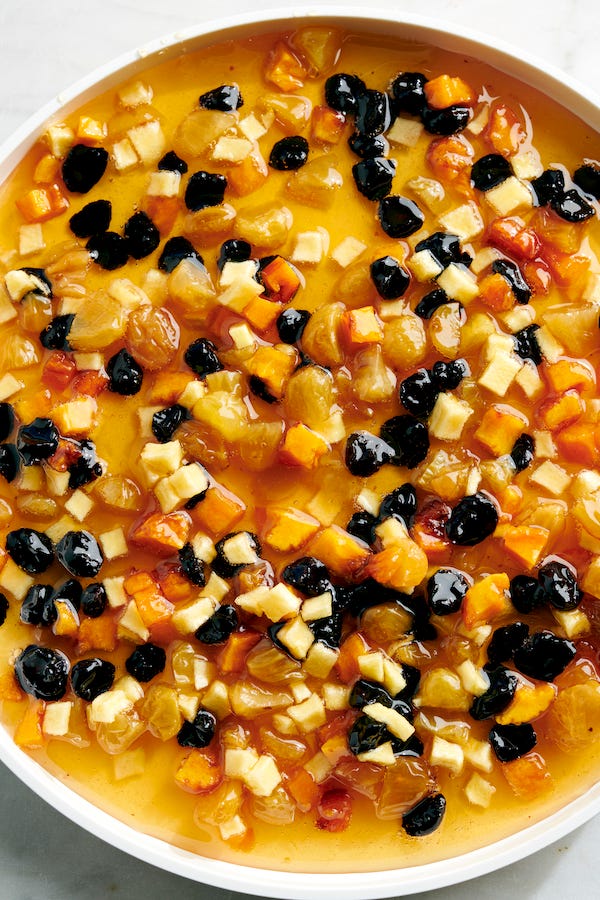
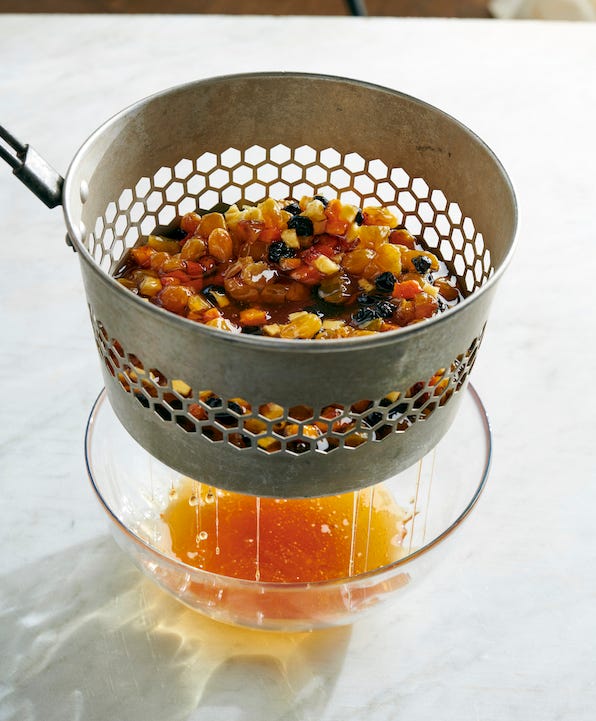
Fermented Honey Charoset
MAKES 3 CUPS
Charoset, a mandatory component of the Passover seder plate, is a fruit and nut mixture that symbolizes the mortar that the ancient Israelites used to make bricks during their years of labor in Egypt. It is eaten with maror—bitter herbs that represent the harshness of exile. Charoset’s sweetness serves to soften that bite.
Although charoset is a universal food of the Jewish diaspora, it has many regional variations. Most familiar to Americans is the Ashkenazic style of charoset, which hails from Eastern Europe and contains apples, honey, cinnamon, wine, and walnuts or almonds. It is often chunky, in contrast to Sephardic-style charoset, which contains binding ingredients like dates and raisins and dried figs that are easily blended into a paste. Other versions reflect even more local tastes: Italians often add chestnuts, while the Jews of Curaçao prepare garosa, a mixture of dates, figs, raisins, peanuts, cashews, and brown sugar shaped into balls.
Our version begins with apples in the Ashkenazic style, but we depart from tradition by adding dried fruits along with aromatics like ginger, cardamom, and orange blossom water. If you want to turn this charoset into a Sephardic-style paste, simply pulse the mixture in a food processor once you have strained it. You don’t need a Jewish holiday to celebrate charoset in any form—we enjoy it year-round.
INGREDIENTS:
1 pound / 454 g raw, unpasteurized honey
1 cinnamon stick
3 whole cloves
10 ounces / 284 g tart apples, such as Granny Smith or Pink Lady, cored and cut into ¼ -inch / 6 mm dice
½ cup / 85 g dried tart cherries, halved or quartered
½ cup / 75 g dried apricots, cut into ¼-inch /6 mm dice
½ cup / 75 g golden raisins (halved if unusually large)
2-inch knob / 13 g fresh ginger, peeled and finely grated
2 tablespoons / 30 ml red wine or pomegranate juice
1 tablespoon orange blossom water
¼ teaspoon ground cardamom
1 ¼ cups / 113 g walnuts, pistachios, or almonds, toasted and chopped
Coarse salt for finishing
PREPARATION:
Place 8 ounces / 227 g of the honey in a 2-quart / 2 L jar along with the cinnamon stick and cloves.
In a large bowl, combine the diced apples, dried cherries, dried apricots, golden raisins, and grated ginger. Stir in the wine, orange blossom water, and ground cardamom. Add to the jar with the honey. Pour the remaining 8 ounces / 227 g of honey over the fruit. Cover the jar with a tight-fitting lid and leave to ferment at room temperature (68º to 72ºF / 20º to 22ºC).
The fermentation steps take time but require little effort. Over the first few hours you will see the honey begin to seep around the fruit. Let the mixture sit overnight. The next morning, give the mixture a gentle stir and cover the jar tightly again. During the next few days, the mixture will begin to bubble. Once it is quite liquid, gently shake the jar every day, being careful to keep the fruit intact. After 1 week, begin tasting the mixture until it has reached the flavor and texture you like. We prefer ours after about 4 weeks, but feel free to ferment it longer; since honey is a preservative, the fruit remains safe at room temperature for months. Once the fruit has fermented to your liking, place it in the refrigerator.
When you are ready to serve the charoset, remove the jar from the refrigerator the night before to make straining easier. Scrape the fruit into a fine-mesh sieve and allow it to drain over a bowl for several hours, covered with a kitchen towel to discourage any bugs.
To serve, add the toasted and chopped nuts to the fruit and sprinkle with a bit of coarse salt over the top.
SERVING SUGGESTIONS:
DOLLOP ON GRANOLA / SERVE ALONGSIDE GRILLED GAME BIRDS / USE UNSTRAINED OVER ICE CREAM OR CREPES / STIR INTO YOGURT / MAKE A CHAROSET CHUTNEY BY MIXING IN CHOPPED FRESH CILANTRO AND MINT


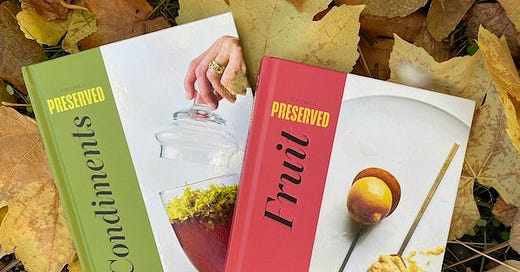


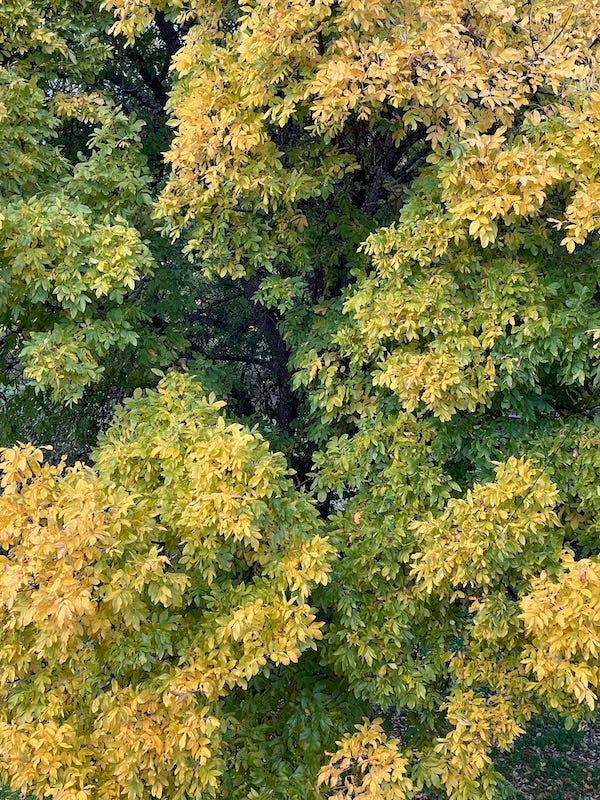
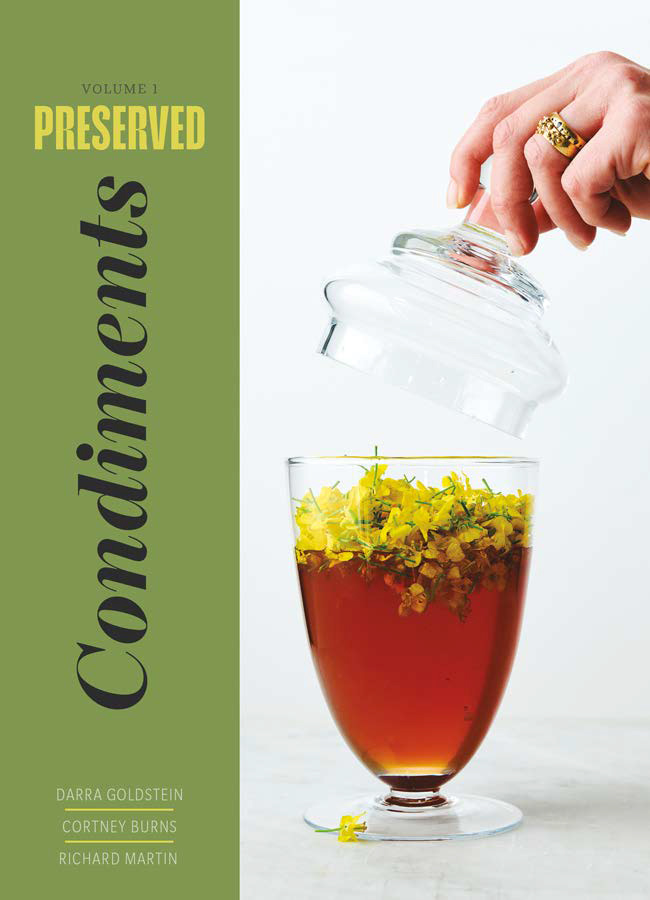
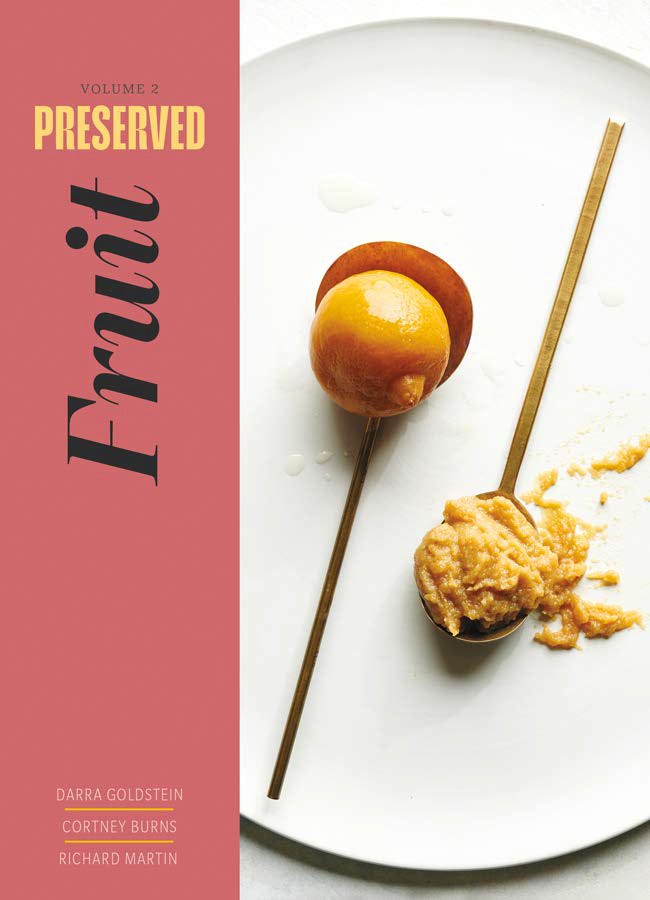
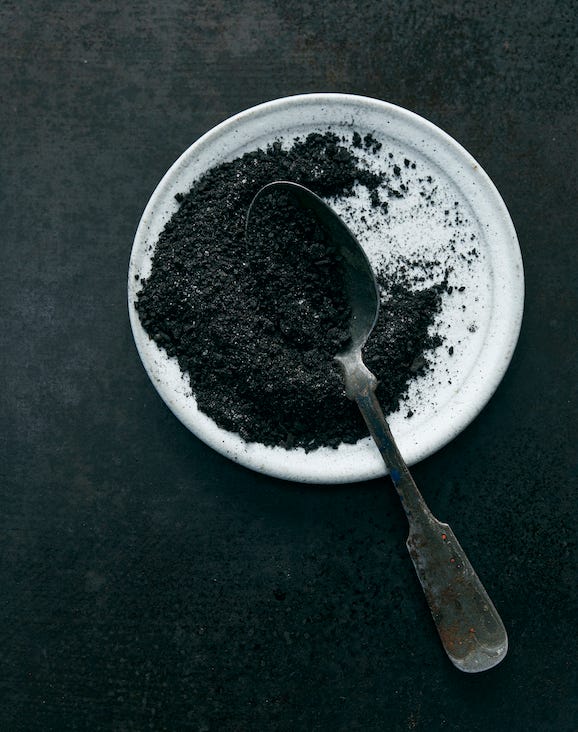
These are exquisite, just right for special occasions or when you’re in the mood to branch out.
Funny, we also had a very yellow light yesterday evening, it was overcast as usual in the wet season afternoons here.
That black salt I’d never heard of before (nor the honey preserved fruit and nuts), it sounds crazy interesting!